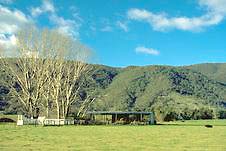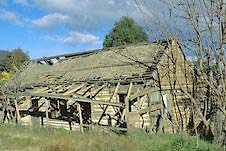
|
| View across the Araluen
Valley |
Araluen
Historic gold ghost town in the heart of the Southern
Tablelands
Located 318 km from Sydney via Goulburn and 364 km via the
Princes Highway, Araluen is one of the most famous gold
towns in New South Wales. Today it is little more than a few
buildings in a beautiful valley noted for its orchards.
It is believed that 'Araluen', probably translated from
the Aboriginal words 'Arr-a l-yin', might mean 'place of the
water lilies'. The first Europeans into the area (Kearns,
Packer and Marsh) arrived in 1822 and by the end of the
decade the area had been accurately mapped. Andrew Badgery
was grazing cattle in the area by the 1830s and by 1837
Henry Clay Burnell had purchased 1280 acres for £265.
Inevitably the goldrushes of the late 1840s disrupted the
area with labourers rushing to the Bathurst area hoping to
find their fortune.
Two Moruya men, Alexander Waddell and Harry 'The
Blacksmith' Hicken, had rushed to Ophir. It was there that
they realised the terrain was remarkably similar to the area
behind Moruya. They returned home and by 1851, having moved
further and further up the Araluen valley, they had
discovered gold.
The discovery of gold led to a rush. Within months there
were 15,000 men in the Araluen Valley. They came to the port
at
Broulee and walked overland for 50 kilometres to the
goldfields. After Ophir this was the most important
goldfield in the state. During its life some $11 million
worth of gold was taken from the field and in the first year
an estimated 100,000 ozs (2830 kg) had been taken.
The town, and access to the town, grew quickly. A road
between Araluen and Moruya was constructed between 1856-61.
In 'Moruya: The First 150 Years' the authors explain: 'The
Moruya River is a salt tidal river as far as the Kiora
Bridge. From there it takes the name Deua River upstream to
its source. Several freshwater creeks, including the Wamban,
flow into it through heavily timbered country. This
combination proved ideal for the miners, especially as rich
wash dirt was found only a foot or two below the surface.

|
| A deserted house in the
Araluen Valley |
'This, however, was worked out quickly, as the high water
table beat the men who attempted deep sinking. Capital was
then put into installing pumping machinery to drain the
workings to sixty feet where the big gold was in the valley
area ...
'Of the gold fields "Thorpes", "The Big and Little
Fenians", "The Good Enough", "All Nations", "Beardys",
"Perseverance", "Blatchfords" and "Picketts" were known rich
producers, and hundreds of smaller holdings were enough to
give a livelihood to thirty-two hotels. Most of these had
their own dance hall, and every month there was a fresh
importation from Sydney of dancing partners ... The dancing
girls' pay was three pounds per week with board and
residence, and for this they contracted to dance three times
per week ... During the brief bushranging era of the
district's history, the Clarke Brothers, Tom and John, were
frequent visitors to the dance halls in the boom days and
were quite popular with the locals (and especially the
girls).'
In 1860, with many of the valleys stripped by overzealous
goldminers, the area was hit by a devastating flood. The
creek grew to over 1000 metres wide and, as reported in 'Moruya
- The First 150 Years': 'The loss of life was heavy. In one
case a hotel and all its occupants were swept away, and the
bodies of several of those in the building at the time were
found afterwards on the beach at Moruya. Much later that
year the workings were reopened but they never returned to
their former glory or excitement.'
Gold inevitably brought with it bushrangers. The Clarke
brothers, who quickly established a frightening reputation
in the district, resisted the temptation to rob the coaches
leaving Araluen. However the arrival of Ben Hall and Johnny
Gilbert was a different matter. On 13 March, 1865, on the
road from Araluen to Majors Creek (it is now impossible to
determine the exact location but if you take the road it is
about 500 metres from the top of the the mountain) and with
the assistance of Tom Clarke, they tried to hold up a gold
escort. They shot at a Constable Kelly but they were
outflanked and were forced to flee from the scene.
Gold continued to be mined until the end of the century
but, after the removal of the alluvial gold, dredges moved
in and the gold fossicking miners moved on. The first dredge
arrived in 1899 and it was eventually followed by 11 other
dredges. They continued to work the valley until 1939. A
detailed booklet The History of Araluen by Lindsay and Roger
Thwaites is published by the Braidwood and District
Historical Society.
Things to see:
![[Top of page]](smlArrow.gif)
Panning for Gold
Don't be too optimistic. If you take the turn towards Majors
Creek from the Braidwood-Araluen Road there is a pleasant
picnic location beside the Araluen River which allows
fossickers the opportunity to try their luck in this famous
alluvial gold river. Unfortunately the area was dredged for
many years and there is not a lot of joy to be had. The
picnic ground is pleasant.
Cemeteries
Further along the Majors Creek road, and clearly signposted,
are the Anglican and Roman Catholic historic cemeteries.
They are both worth visiting. It is hard to imagine, given
the small population now living in the valley, that so many
people could have once lived (and died) in the valley.
The Mullock Heaps
If you look across to the river from the road which runs
along the valley towards the Hotel you will notice strange
mounds. They are now commonly green and grassy. These were
once the mullock, waste heaps left by the dredging of the
valley.
The Roads
The easiest access is the 25 km route from Braidwood which
is sealed and uncomplicated. The prettiest, and also most
precipitous, is the 12 km dirt track (to call it a road is
to overstate its importance - hope you don't meet any
oncoming traffic) from Majors Creek which drops
spectacularly into the valley and offers the best entry
through rich orchards and past both the cemeteries before
joining the Braidwood road. The road through to Moruya is
mostly a dirt road which is quite accessible although it is
probably quicker to return to Braidwood and drive to the
coast via the Kings Highway to Batemans Bay.

Broadwalk
Business Brokers
Broadwalk Business
Brokers specialise in General Businesses for Sale, Caravan Parks for
Sale, Motels for Sale, Management Rights & Resorts for Sale, Farms for
Sale, Hotels for sale,Commercial & Industrial Properties for Sale.
Phone:
1300 136 559
Email:
enquiries@broadwalkbusinessbrokers.com.au
AUSTRALIAN BUSINESSES FOR SALE
COFFS HARBOUR BUSINESS BROKERS
BROADWALK BUSINESS BROKERS
GOLD COAST BUSINESSES FOR SALE
BRISBANE BUSINESSES FOR SALE
SYDNEY BUSINESSES FOR SALE
CARAVAN PARKS FOR SALE
BUSINESSES FOR SALE
MOTELS
FOR SALE
HOTELS
FOR SALE
Disclaimer
We advise prospective purchasers that we take no
responsibility for the accuracy of any information in the business
provided by vendors or their professional advisers and that they should
make their own enquiries as to the accuracy of this information,
including obtaining independent legal and/or accounting advice
Araluen